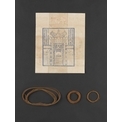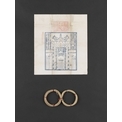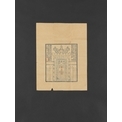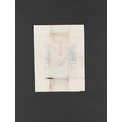
- Laosantai Huihui Tang Strings (Made in the late Qing Dynasty)
These strings were a gift for Tsar Teh-yun from Zheng Minzhong, Beijing qin master, on 26 April 1996. Tsar Teh-yun has made remarks on the wrapping in pencil. It is a tradition for qin players to exchange gifts of qin accessories.
Laosantai first appeared towards the end of the Qing Dynasty. The sharp outline of the print on the fangtie (wrapping with advertisement) shows that the wood block for the printing was in an early stage of use. So this set of strings is an earlier product of Laosantai.
One of the two key traditional methods is used to tie the strings together, i.e. tied with the end of the strings. The other method is to tie the strings with coloured threads, such as Laosantai Huihui Tang Strings made in the early years of the Republic of China. Either of these two methods has been used over the years. Usually, the first to fourth strings and the fifth to seventh strings are tied in separate bundles, with a separate bundle of spare string.
The exhibit has changed its colour and become brittle and can no longer be used.

- Laosantai Huihui Tang Strings (Made in the early years of the Republic of China)
The print on the wrapping was from the same wood block as that used for the Laosantai Huihui Tang Strings made in the late Qing Dynasty, but the print has become blurred, showing that the printing was made at a later stage. On the left hand side of the wrapping, there is another red print to the effect that “We are on Sanyuan Road in Hangzhou, opposite to the Bank of China”. The Bank of China was set up by Dr Sun Yat-sen in the first year of the Republic of China (1912). Evidently, these strings are products after the establishment of the Republic of China. They are also the last batch of Huihui Tang Strings, and most extant Huihui Tang Strings are from this batch.
The strings are in good condition and can still be used.

- Fangtie of Loubaolong Huihui Tang Strings (Made in the late Qing Dynasty)
Loubaolong was one of the traders of Huihui Tang Strings in the late Qing Dynasty. It was specified on the wrapping that these were “Taigu strings of jiuxing liuhe made in the traditional method”, different from other brands of Huihui Tang Strings.
The strings have already been lost. Only the wrapping has remained.

- Fangtie of Laosantai Huihui Tang Strings (suspected to be a fake, made in the late Qing Dynasty or t...
After the Tongzhi period (1862-1874) of the Qing Dynasty, qin strings were sold under different names of the Huihui Tang brand. There were differences in the patterns of the advertisements on their wrappings. After the appearance of Huihui Tang by Lu Wenrong of Shaoxing during the Daoguang period (1821-1850), the patterns on its wrappings were copied by many different operators, including Laosantai, but under different trade names. In fact, all Huihui Tang Strings were fakes, except those made by the Li Shiying family.
The paper used for this wrapping of Laosantai Huihui Tang Strings is yukou paper, which is poorer in quality than the ma paper or xuan paper generally used. The printing is also poor and the colour has faded. Though the pattern is the same as that of Laosantai Huihui Tang Strings, it can be seen that the printing is not from the same wood block. This should be a fake, and is the first example of copying even the brand name.
